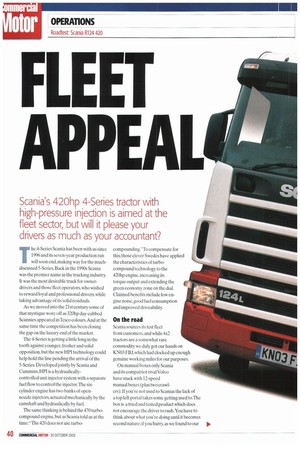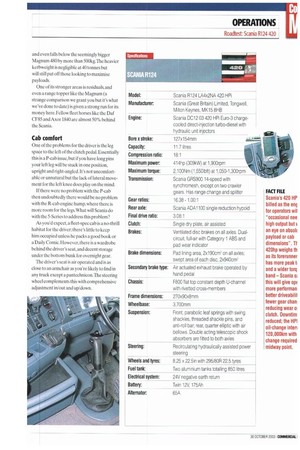FLE ET
Page 40

Page 42

Page 43

If you've noticed an error in this article please click here to report it so we can fix it.
APPEAL
Scania's 420hp 4-Series tractor with
high-pressure injection is aimed at the
fleet sector, but will it please your
drivers as much as your accountant?
The 4-Series Scania has been with us since 1996 and its seven-year production run will soon end, making way for the muchdiscussed 5-Series. Back in the 1990s Scania was the premier name in the trucking industry. It was the most desirable truck for ownerdrivers and those fleet operators, who wished to reward loyal and professional drivers, while taking advantage of its solid residuals.
As we moved into the 21st century some of that mystique wore off as 320hp day-cabbed Scannies appeared inTesco colours.And at the same time the competition has been closing the gap on the luxury end of the market.
The 4-Series is getting a little long in the tooth against younger, fresher and solid opposition, but the new HPI technology could help hold the line pending the arrival of the 5-Series. Developed jointly by Scania and Cummins. HPI is a hydraulically controlled unit injector system with a separate fuel flow to control the injector.The six. cylinder engine has two banks of opennozzle injectors, actuated mechanically by the camshaft and hydraulically by fuel.
The same thinking is behind the 470 turbocompound engine,but as Scania told us at the time: The 420 does not use turbo compounding."To compensate for this, those clever Swedes have applied the characteristics of turbocompound technology to the 420hp engine, increasing its torque output and extending the green economy zone on the dial. Claimed benefits include low engine noise, good fuel consumption and improved driveability.
On the road
Scania sources its test fleet from customers, and while 4x2 tractors are a somewhat rare commodity we duly got our hands on KNO3 FBI which had clocked up enough genuine working miles for our purposes.
On manual boxes only Scania and its compatriot rival Volvo have stuck with 12-speed manual boxes (plus two crawl ers). If you're not used to Scanias the lack of a top left portal takes some getting used talle box is a tried and tested product which does not encourage the driver to rush.You have to think about what you're doing until it becomes second nature: if you hurry, as we found to our cost, it will find neutral for you.
Unless we were facing downhill or rolling towards traffic lights as they turned green we found 1H was the best gear for getting under way.From here it was either 2H,3H then into the top range or, if momentum allowed, a three-gear jump to 3L before going into the top half of the box.
The torque band on the new-look 420 HPI falls sharply after 1,300rpm from the 2,100Nm plateau down to 1.800Nm at 1.600rpm. If you change after 1,350rpm a full gear drops you down to around a 1,000rpm and a split to 1,150rpm. On the longer hill climbs you can lug down well towards 900rpm if the crest is close enough not to warrant a change; otherwise get the revs back up towards that golden 1300rpm and you won't go far wrong.
The torque-based 420 HPI stands up well enough against its competitors. MAN's 410hp TGA engine enjoys bragging rights on lugging down, but if the revs fall too far it can take an age to regain forward momentum.
It's debatable whether fleet drivers prefer automatics over manuals,and whether auto will ever be as frugal as a good driver using manual. In any case. Scania has hedged its bets with the GRS900, making it functional rather than flashy.
The gearstick was revamped last April into a joystick shape with the range-change at the front for the driver's fingers and the splitter under the thumb of his left hand.The gate into the crawler/reverse section on the far left has a subtle harrier rather than a brick wall so heavy-handed drivers will go through it more than once in search of the first and fourth gear portal.
On the acceleration test we now use the torque boundary, promoting professional driving,rather than using the power restrictions,so the figures are markedly different.We believe these times are more realistic and out on the road this practice is certainly a lot safer and better controlled.
The cruise control is dated but still an effective tool, It cuts out automatically when the clutch or service brakes are used,but also has an off button and resume switch.The latest cruise controls automatically resume after each gear change. avoiding the chore of re-engaging every time:the 5-Series is expected to include this feature.
This is a working wagon rather than a Scania demo truck so the usual press-fleet whistles and bells are missing.There's no security alarm or engine immobiliser, for example, but both are available as options. Secondary braking is left to the standard exhaust brake found at the top of the foot brake.This needs at least 2,000rpm and a change down to make it effective but still isn't nearly sharp enough so the foot brake is invariably required too.
Fleet operators have never queued up to invest in added extras, so if the manufacturers really want to enhance road safety with retarders and the like they should fit them as standard.
Road handling is solid and responsive.As we hit nearly all roundabouts in 4L/11 and the bigger ones in fifth there was enough roll to give us a feel for the manoeuvre without ever feeling endangered.
Scania has moved the wing mirror down the arm to give a better view at roundabouts and junctions. On the downside, however, tall drivers will find the top of the windscreen is a little low and this blocks the sky out.
Productivity
With the RI 24's fleet-friendly engine rating we expected it lobe ahead of the Magnum on fuel but behind it on average speed, and that's exactly what happened. On day one the R124 was not as frugal as the Magnum or the Oaf CF85,but over the tougher section on day two it was able to make up for lost ground on the motorway.
Its best section was over the easy A-roads where it topped lOrnpg.Average speed was down in all sections against Renault's flagship but was close to the figures achieved by the Daf and Merc's Axor 1840.
The 25.35-tonne payload on five axles does not stand up so well against its competitors and even falls below the seemingly bigger Magnum 480 by more than 500kg.The heavier kerbweight is negligible at 40 tonnes but will still put off those looking to maximise payloads.
One of its stronger areas is residuals, and even a range topper like the Magnum (a strange comparison we grant you but it's what we've done to date) is given a strong run for its money here. Fellow fleet horses like the Daf CF85 and Axor 1840 are almost 50% behind the Scania.
Cab comfort One of the problems for the driver is the leg space to the left of the clutch pedal. Essentially this is a P-cab issue, but if you have long pins your left leg will be stuck in one position, upright and right-angled. It's not uncomfortable or unnatural but the lack of lateral movement for the left knee does play on the mind.
If t here were no problem with the P-cab then undoubtedly there would be no problem with the R-cab engine hump, where there is more room for the legs. What will Scania do with the 5-Series to address this problem?
As you'd expect, a fleet-spec cab is a no-thrill habitat for the driver: there's little to keep him occupied unless he packs a good book or a Daily Comic. However, there is a wardrobe behind the driver's seat, and decent storage under the bottom bunk for overnight gear.
The driver's seat is air operated and is as close to an armchair as you're likely to find in any truck except a pantechnicon.The steering wheel complements this with comprehensive adjustment in/out and up/down.




























































































































































































